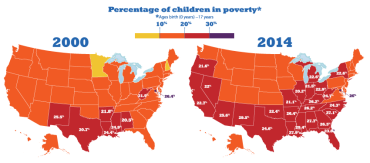Growth in child poverty mapped by county in the 50 states
Alabama │Alaska │ Arkansas │ Arizona │ California │Colorado │Connecticut │ Delaware │District of Columbia │ Florida │ Georgia │ Hawaii │Idaho │ Illinois │ Indiana │ Iowa │Kansas │Kentucky │Louisiana │Maine │Maryland │Massachusetts │Michigan │ Minnesota │ Mississippi │ Missouri │ Montana │ Nebraska │ Nevada │ New Hampshire │ New Jersey │ New Mexico │ New York │North Carolina │ North Dakota │ Ohio │Oklahoma │ Oregon │ Pennsylvania │ Rhode Island │South Carolina │South Dakota │Tennessee│Texas │ Utah │Vermont │Virginia │Washington │West Virginia │Wisconsin │Wyoming
U.S. trends of child poverty moving in the wrong direction
We hear that the global recession has abated, but for many families around the United States, the impact of this crisis still reverberates. The AFT has studied child poverty statistics from the U.S. Census Bureau and has used the data to unmask disparities in educational equity. This is especially important in light of the Organization for Economic Cooperation and Development's 2012 Program for International Student Assessment study finding that the most important factor in score variation for American students was socio-economic background. The AFT's state-by-state and county-by-county maps of child poverty have provided a wake-up call for many state-elected leaders, and the graphics have sparked discussion about what it means to have nearly one in four U.S. students living in poverty. The reality is that the United States needs to do a better job in directing tools and resources to the students and schools that need them the most.
Last year, the U.S. Department of Education released "For Each and Every Child: A Strategy for Education Equity and Excellence," a report of the congressionally appointed Equity and Excellence Commission, of which AFT President Randi Weingarten was a member. Its charge was to provide advice to U.S. Education Secretary Arne Duncan on the disparities in meaningful educational opportunities and to recommend ways in which federal policies can address such disparities.
"The report called for concrete investments in wraparound services and preschool; spelled out how to help and sustain the teaching force we need, not by shaming and blaming teachers but by supporting them; and detailed the need for high-quality curricula, teaching resources, safe and nurturing schools, and collaborative learning environments," says Weingarten. "That's the agenda we should be focused on to help all of our children succeed.
"This report is the closest thing we have had to a blueprint—crafted by people from across the ideological spectrum—for laying out the necessary programs and policies that the United States can take to close its shameful equity gap between the haves and have-nots. We owe this to all our children. We strongly urge leaders to do at long last what is not only morally right but necessary to ensure a healthy democratic society with a thriving economy."
The list above details, state by state and county by county, the changes in child poverty rates from 2000 to 2012. The stark changes in many states illustrate the widening income gap between affluent and poor households, which reduces economic growth, jeopardizes socio-economic mobility (a key element to the American dream), and increases demand for quality public services at a time when state and local tax bases are shrinking.
In education, high-performing countries address socio-economic disparities by directing resources to the schools and students with the greatest need. Countries like Brazil, China and India are dramatically expanding access to preschool, reflecting a growing consensus that transcends political ideologies and geographic boundaries—that skills development starts at birth and lays the foundation for achievement in school, college, career and life.
This phenomenon impacts all aspects of a person's life, and it aligns with the AFT's vision for reclaiming the promise of public education. Reclaiming the promise is about fulfilling our collective obligation to ensure that every person has the opportunity to succeed and live a productive life. It is about providing:
- High-quality public education for all children that nurtures a joy of teaching and learning;
- access to early childhood care and education for all families, including the supports they need;
- access to affordable and excellent higher education;
- the resources and staffing our hospitals and medical centers need to provide world-class patient care;
- properly funded and dependable public services and programs that meet the needs of our communities; and
- safeguards for retirement security for all working women and men.

